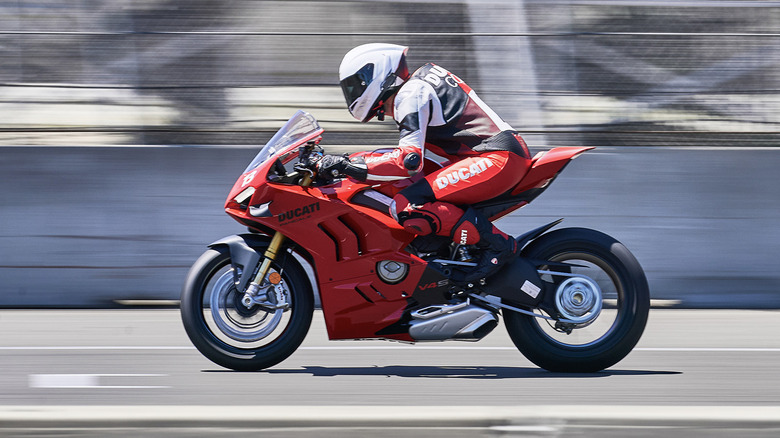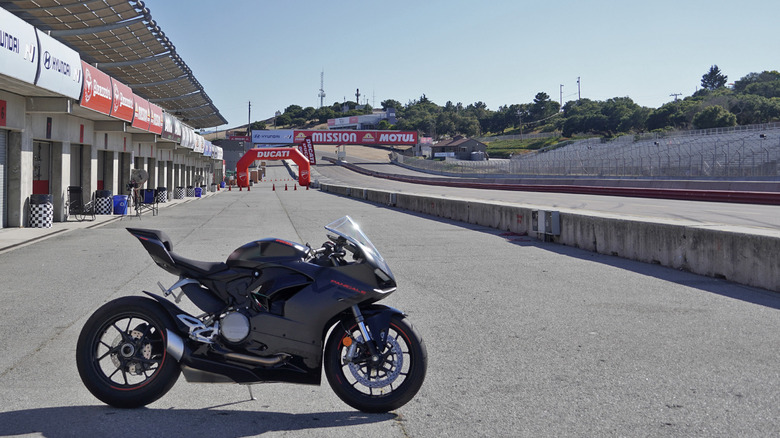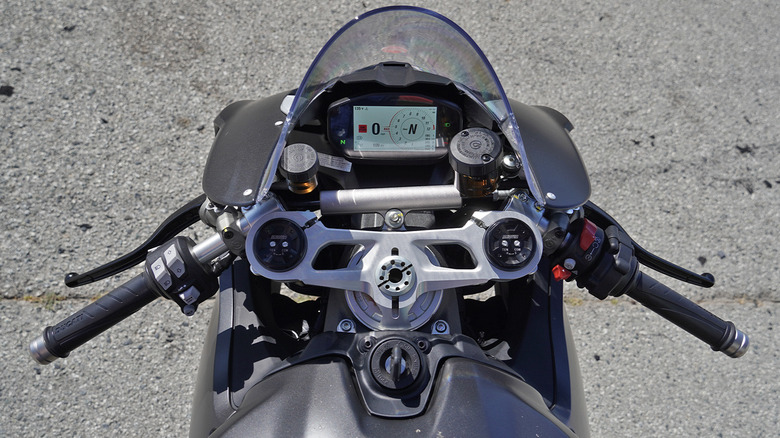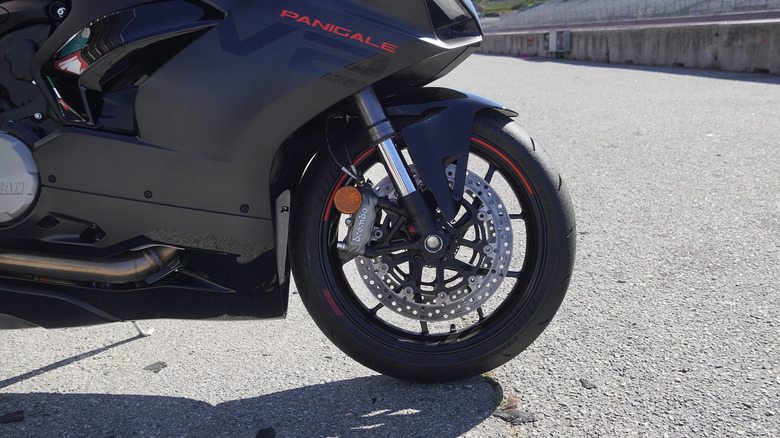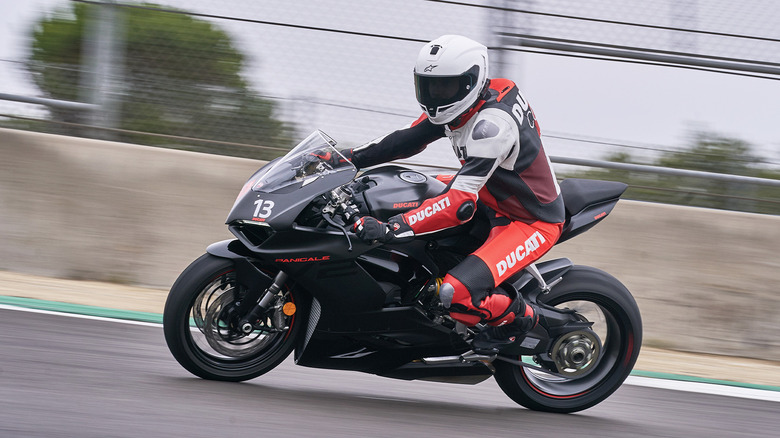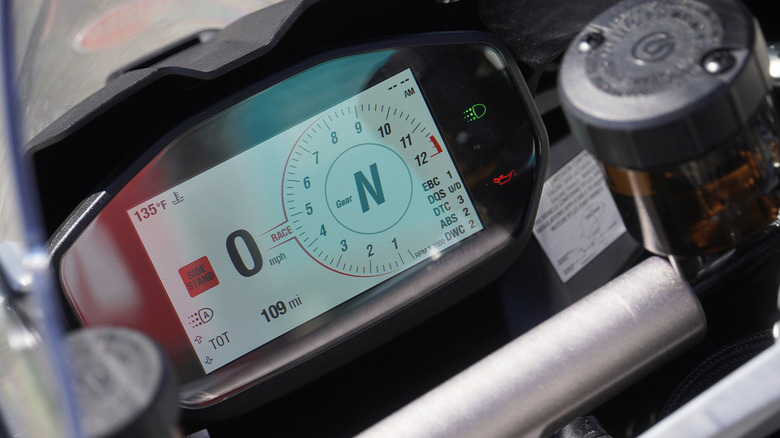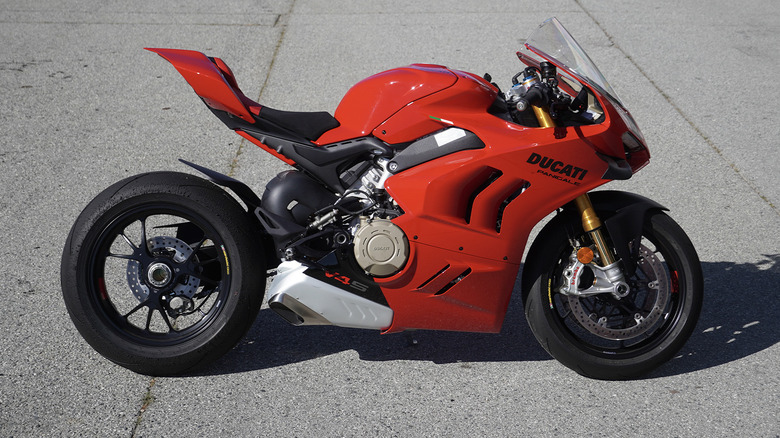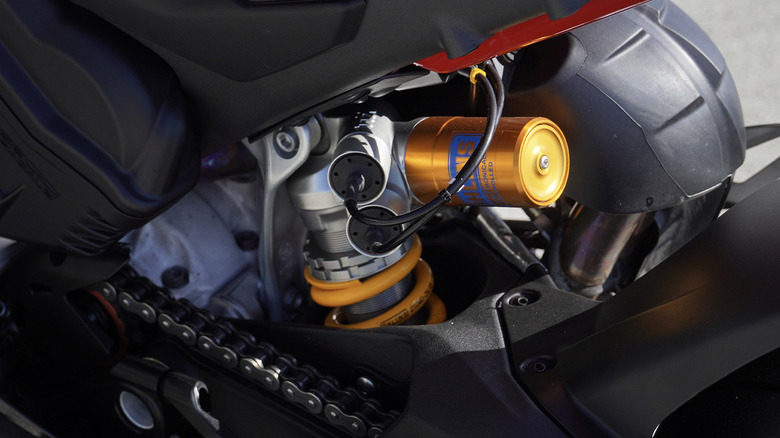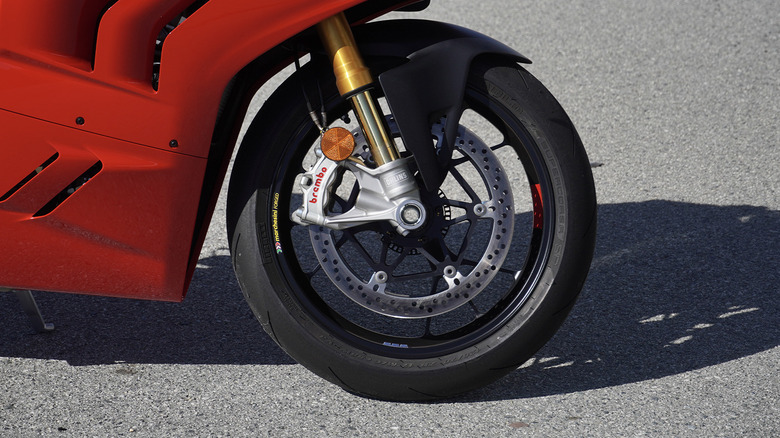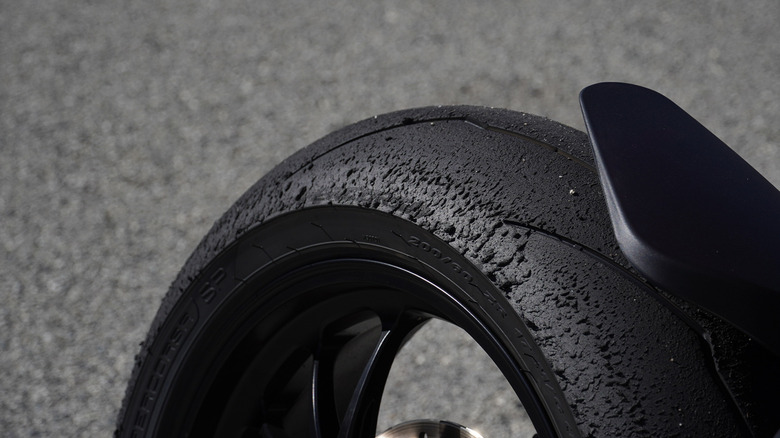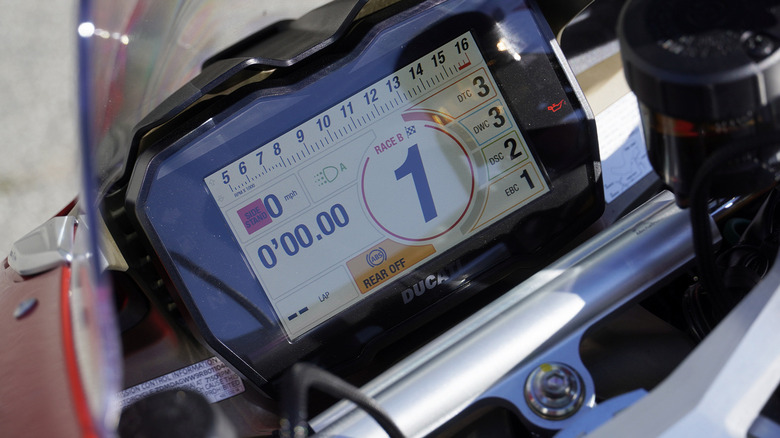Ducati Panigale V2 Vs V4 S Track Showdown: Putting A $32,000 Bike To The Test
Learning to ride high-performance motorcycles on the racetrack results in massive boosts to confidence, skill, and safety while riding on public roads. But in the life of an auto/moto journalist, the actual learning process can easily approach a sporadic rollercoaster ride while jumping between so many different bikes, with varying displacements, a neverending onslaught of new gear, and handling all of the above at different circuits the world over. My own saga of motorcycle track training recently culminated in a peak life experience, though, when I joined Ducati's DRE program to ride some of the most iconic modern motorcycles on one of the world's most iconic motorsport destinations, WeatherTech Raceway Laguna Seca.
Little did I know, as I drove up from Los Angeles, that Ducati not only planned to plop me onto three spectacular bikes, but also with legendary racer turned professional riding coach Jake Zemke shadowing me for the full day. That's because I spent most of the drive fretting about Laguna Seca itself, which is actually far from my favorite track to run in a car—ever since I came fairly close to the edge while testing the Hyundai Ioniq 5 N there earlier this year.
Turns out, the famous Corkscrew concerns me far less than Turn 1's blind crest over a hill at top speed. So as I suited up in Laguna Seca's pitlane, I wondered how I might fare on the Panigale V2, which would be the most powerful bike I'd ridden on track up to that point by a fair margin, not to mention the insanity of a V4 S superbike later. Not quite slowly, but very much surely, I learned how to push each bike and myself closer to the limit, while receiving a solid education on whether the V2 or V4 S makes for a better track toy in the process.
First impressions of the Panigale V2
Even the entry-level Panigale V2 sounded fairly wild to me that misty morning, with 155 horsepower from a 955cc V-twin cradled in a lightweight and nimble frame, able to rev that V-twin up past peak power at 10,750 RPM. Yet for an entry-level sport bike, the V2 still starts at $18,595. That serious price tag means the V2 needs to leave dealer floors fully featured, with plenty of different ride modes and specific programming available through a moderately intuitive display and easily toggled switchgear.
The V4 S is simply an entirely different beast, though. The 1,103cc V4 engine puts out 210 horsepower on the way to a 15,500-RPM redline, and how about that $31,995 starting sticker? Way up the ladder in terms of both functional styling and performance, the V4 S looks just as exotic as the advanced engineering suggests: a counter-rotating crankshaft straight out of MotoGP, electronically adjustable suspension, and far more discrete control of traction and ABS programming.
A day at DRE
Amid a veritable sea of Ducatis, my V2 turned very few heads. Most customers pulled up on personally owned V2s, anyway, as perhaps expected. But a few V4 Rs and even a Superleggera, plus full custom track bikes, all drew much more attention. I wondered whether stepping up to that level makes any sense at all, given how good the matte black V2 looked as I limbered up in the garage.
This story will focus less on track coaching and more on the bikes themselves, but coaching needs to come into play at least a little bit. Before the first morning session, Zemke wanted me to spin a few small donuts in the parking lot to give me a chance to adjust to the bike, as he checked out my technique.
Coaching and testing, all at once
By now, I can generally adapt to a new motorcycle fairly quickly, since the job dictates doing just that on a regular basis. And the better the bike, the quicker the adjustment period. Slow circles left and right before even acclimating to the geometry, weight distribution, throttle response, and clutch bite tend to leave me feeling—and looking—fairly clumsy. Luckily, the V2 initially felt similar in size and weight to the Kawasaki Ninja ZX-4RR I'd ridden for my previous two track days, albeit with a noticeably improved sense of refinement at every touchpoint.
Of course, the added power of a rev-happy V-twin changes the game a bit, but I eased into the tractable throttle response slowly as the bike tipped in almost as twitchily as the Ninja. I never particularly enjoy going slowly on motorcycles, much less in a parking lot, so perhaps I need to do so more often. But Zemke gave me a few pointers and then admitted I might do better adjusting on a few sighting laps out on the big track. Great, let's get to it.
A sighting lap as adjustment period
Even on my out lap, I spent some time shimmying my hips, wiggling my elbows, and fumbling around with my feet on the pegs to find my ideal positioning. And the V2 fit me quite well, for a smaller sport bike and given my lanky 6'1" frame. The seat rides a bit lower than expected and the handlebars a bit wider, and I noticed even early on some softer suspension movement under hard braking. I started sliding my hips off the saddle, tipping in deeper through corners where the V2 settles into a nice rhythm, and then revs right up toward redline with that twin asking for more the whole time, before the quickshifter rips up through gears higher on the tach.
By the time Monterey's morning fog started to burn off and the track looked warmer, I finally found myself hitting full throttle, staying wider and forcing my mind not to roll off the juice going over Turn 1. The Corkscrew, meanwhile, took a few more tries than expected, as I almost needed to turn it into three separate transitions. But really, the longer sweepers at Laguna Seca make for excellent motorcycling education, with plenty of runoff when I swung wide and lots of room to explore new lines past apex.
Eventually stepping up to Race mode
Zemke's first few rounds of coaching then opened up the V2's potential further—in my hands, anyway. First I stepped up into Race mode on the simple little gauge cluster. And he wanted me to stop centering on the saddle during full-throttle rips, or really ever at all. He also admonished me to set up my body positioning for each turn before even braking or downshifting, then tip in earlier and, as usual, believe in the bike and tires' ability to hold more speed at greater lean angles, while using more of the corner exit. Soon enough, on my V2 I started ripping past the liter bikes in my intro group.
Then we took a lunch break, which gave me a few minutes to ponder the prospect of a V4 S coming right up. Oh boy. Even at first glance, as I sidled up to the Rosso Corsa superbike in my garage, I spotted the differences. The higher seat, slightly wider tank, lower and narrower bars, higher pegs. Time to get serious.
The Panigale V4 S, ladies and gents
Set to Sport mode, the V4 S initially restricted power during my first stint out. And probably for the best, too, because all the expletives in the world can't explain how around a third more power feels like three times as much. Somehow jumping from the V2 to V4 S felt like an even bigger leap than from the ZX-4RR to the V2.
Yet perhaps because of Zemke's coaching, my confidence built up quickly. I still only hit full throttle maybe once or twice in that entire first session, before pulling into the pits to chat some more. I told him how much I felt the additional power, of course, but also the added weight sort of pushing me out wider at apex as I leaned into turns. But then he told me the V4 S weighs less than the V2. Surely not, I thought, and needed to Google the two bikes' respective poundage. Turns out the pros know, and the V2 weighs 388 pounds dry or 441 pounds wet, versus the V4 S at 384 pounds dry and 431 wet.
Push harder and the V4 S only takes more
My mind balked, then I spouted the one bit of knowledge I knew: Maybe the counter-rotating crankshaft causes additional gyroscopic inertia. To his credit, Zemke never laughed in my face, instead calmly explaining that the effect would be the exact opposite. Then he taught me how to play with the V4 S's many riding modes, and recommended I switch into Race B with the engine braking turned up and the Öhlins suspension set to a single mode, rather than adaptive.
All of a sudden, magic. So steady, so predictable, so forgiving, and just so incredibly, unbelievably, deceptively fast. As I ripped off my downshifts earlier and earlier, the quickshifter smoothly blipping through the revs, I needed all the brakes in the world and the V4 S delivered. I wanted to lean more, and then transition back upright to give more gas before raising up my torso. No problemo. Each lap, I minimized the time spent off both the throttle and brakes, even managed a full lap without returning to the center of the seat once, pulling far past the blind crest of Turn 1, scraping both knees through quick transitions over the Corkscrew, feeling little wheelies up the front straight and back hill. Into the flow, and the most serious flow I've felt on a motorcycle—then or since.
A full 40 minutes straight of motorcycle nirvana
I took a break from the V4 S to try out the patently absurd Multistrada RS for a couple-few laps, which revealed how much everything I learned on a sport bike only gets amplified while upright on a top-heavy ADV cruiser (albeit one equipped with a racing engine and unbelievable suspension and ridiculous brakes). The Multi RS is an incredible machine, and expect to read more about it later, but after just three or four trips around Laguna Seca, swan diving over the Corkscrew, I just wanted to get back onto my darling.
For my final session of the day, I took the V4 S out again with the advanced group and shockingly managed to hold my own. Then I stayed out for another session, thinking that 40 minutes straight at the end of the day might do good for the body and mind to coalesce around such a stupendous superbike. By the end, I felt exhaustion creeping in, even as the V4 S seemed to make each lap easier the faster I pushed the pace. But when the body and mind start to fade on motorcycles... The final chequered flag probably came at the perfect time, before I found the edge, obviously of my skills and not the Panigale V4 S, which wanted to just keep flogging those Pirelli tires to the bone.
Panigale V4 S as daily rider
A dream day, to say the least. But as a fitting coda, Ducati then loaned me a V4 S to rip around through traffic during Monterey Car Week the next month. Now, believe you me, the Panigale V4 S makes for quite a miserable commuter, an absolutely charcoal grill between the legs and way too tall of gearing for slow-speed lane-splitting. Plus, this one arrived with GP-style shifting and somebody had clearly blown through the clutch.
Yet other than the conditions, I actually spent my few days on that V4 S surprised by how little my wrists and forearms ached, at how much visibility I retained despite the low posture, and of course at how much fun the bike delivered on the rare occasions that traffic actually opened up. Plus, using a sky-high redline and up/down quickshifter—the latter one of the biggest reasons to buy a modern motorcycle—helped me avoid money shifting or lugging the engine.
Final verdict: Panigale V2 vs V4 S
So back to the big question: For a weekend canyon carver or track toy, if not that daily commuter, is the Panigale V4 S actually worth the money versus a V2? In my mind, there's really no question at all: It's merely a question of budget. And in all fairness, the V2 still impressed me as a stupendous piece of engineering, and will serve as plenty of bike for 99.9% of road riding.
But more power, plus more sheer technical proficiency combines to convince me that nothing, bar nothing, in my experience thus far creates and coaxes out that flow quite as well as the V4 S. How could any bike get better, I wondered, pondering the V4 R.
And then Ducati announced the 2025 V4, a totally updated generation with divisive looks and, surprisingly, no single-sided swingarm. And it's a huge bummer, not because of the above, but because if the Ducatisti decide they prefer the outgoing generation, then used values will stay higher and I will never get a chance to actually own my darling. Because I sure can't afford a $30,000 superbike, and certainly don't need one. Which means I'll simply need to resign myself to consoling memories of that DRE day at Laguna Seca for the foreseeable future. But at least once, for an afternoon if not a bit more, I did get a chance to experience the equivalent of modern motorcycling nirvana.
